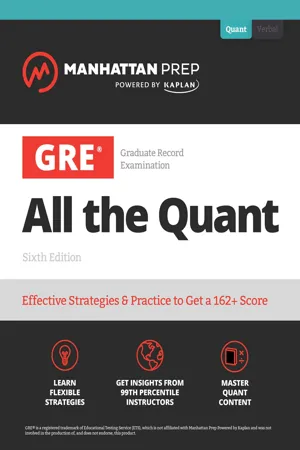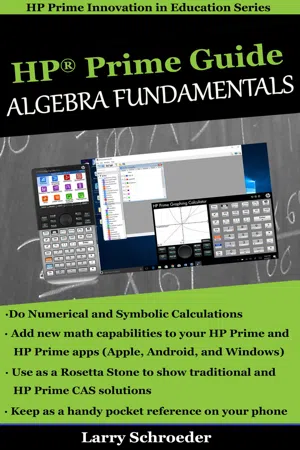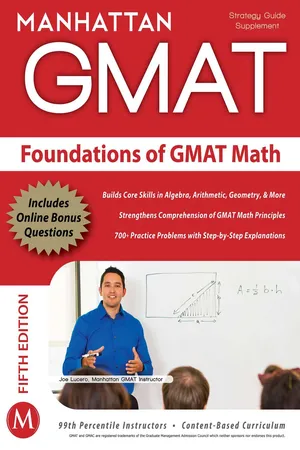Mathematics
Powers Roots And Radicals
Powers, roots, and radicals are fundamental concepts in mathematics that involve manipulating numbers and expressions. Powers refer to raising a number to an exponent, roots involve finding the inverse operation of raising a number to a power, and radicals are expressions that involve roots. These concepts are essential for understanding algebra, calculus, and other advanced mathematical topics.
Written by Perlego with AI-assistance
Related key terms
Related key terms
1 of 4
Related key terms
1 of 3
4 Key excerpts on "Powers Roots And Radicals"
- eBook - ePub
GRE All the Quant
Effective Strategies & Practice from 99th Percentile Instructors
- (Author)
- 2023(Publication Date)
- Manhattan Prep(Publisher)
CHAPTER 5 Exponents and RootsSo far, exponents have been defined as a shorthand way of expressing multiplication. For example, 52 = 5 × 5 = 25 and because 92 = 81. For larger numbers, however, this approach could be prohibitively time consuming, and it’s all but impossible when you have variables. In this chapter, you’ll learn all of the exponent and root rules that will allow you to combine exponential terms and simplify complex expressions.Exponents and Roots Language
Have you ever heard the expression, “Wow, that increased exponentially!”? This expression captures the essence of exponents. When a number greater than 1 increases exponentially, it does not merely increase; it increases a significant amount and it does so very rapidly.In fact, the greater the exponent, the faster the rate of increase. Consider the following progression:This trend holds true when positive bases greater than 1 are raised to higher and higher powers. With many other numbers, though, this trend will not necessarily hold true. For example, when the number 1 is raised to any exponent, it does not increase at all; it remains 1.The expression 43 consists of a base (4) and an exponent (3). This expression is read as “four to the third power” or “four cubed” and means four multiplied by itself three times. Thus, four cubed is 43 = 4 × 4 × 4 = 64.Roots undo exponents. Asking for the cube root of 64 is the same thing as asking “What number, when cubed, gives 64?” Thus, . Four cubed is 64, and 64 cube rooted is 4.Most exponents will be expressed as “the base (raised) to the power of the exponent.” So 35 is called “three to the fifth power” (and equals 243, incidentally). To undo that, you would take the fifth root of 243, which is written as and which equals 3.Something raised to the second power is called a square, and something raised to the third power is a cube. After that, use the number of the power (fourth power, fifth power, sixth power). For second and third powers, the GRE may use either the special names (square, cube) or the more traditional ones. - eBook - ePub
HP Prime Guide Algebra Fundamentals
HP Prime Revealed and Extended
- Larry S Schroeder(Author)
- 2017(Publication Date)
- Larry Schroeder(Publisher)
Explanation 1.4 – Radicals and Rational Exponents
In this section we introduce radicals and rational exponents. We start by going over the difference between the square root of a number and the principal square root. We expand this to the nth root and the principal nth root.We then use the radicals to define rational exponents. The rational exponents are also referred to as fractional exponents. It can be shown from the Definition of Rational Exponents that the Properties of Exponents hold as well.We conclude this section with eliminating radicals in the denominator. This process is referred to as rationalizing the denominator.Radicals and Their Properties
A number is squared when it is raised to the second power. Many times we need to know what number was squared to produce a value of a. If this value exist we refer to that number as a square root of a.Thus25 has -5 and 5 as square roots since (-5)2 = 25 and (5)2 = 25,49 has -7 and 7 as square roots since (-7)2 = 49 and (7)2 = 49,-16 has no real number square root since no real number b where b2 = -16.Zero only has itself as a square root. We will later add the complex number system where square roots exist for negative numbers.HP Prime Family Square Root - solveBegin by selecting the CAS key on the HP Prime. If the CAS view of the screenshot has computations, clear the history first. To clear the history, press the Clear key.Key in as shown. Use the Toobox key to enter solve() . Select Toolbox > CAS > Solve > Solveand press Enter - eBook - ePub
- Manhattan GMAT(Author)
- 2011(Publication Date)
- Manhattan Prep Publishing(Publisher)
Chapter 3: Exponents & RootsIn This Chapter:• Rules of exponents • Rules of roots Basics of ExponentsTo review, exponents represent repeated multiplication. The exponent, or power, tells you how many bases to multiply together.53 = 5 × 5 × 5 = 125 Five cubed equals three fives multiplied together, or five times five times five, which equals one hundred twenty-five. An exponential expression or term simply has an exponent in it. Exponential expressions can contain variables as well. The variable can be the base, the exponent, or even both.a4 = a × a × a × a a to thefourth equals four a's multipliedtogether, or a times atimes a times a.
Any base to the first power is just that base.3 x= 3 × 3 ×…× 3 Three to thexth power equals three times three timesdot dot dot times three.There are x three's in theproduct, whatever x is.
Memorize the following powers of positive integers.71 = 7 Seven to the first equals seven. Squares Cubes 12 = 122 = 432 = 942 = 1652 = 2562 = 3672 = 4982 = 6492 = 81102 = 100112 = 121122 = 144132 = 169142 = 196152 = 225202 = 400302 = 900 13 = 123 = 833 = 2743 = 6453 = 125103 = 1,000 Powers of 2 21 = 222 = 423 = 824 = 1625 = 3226 = 6427 = 12828 = 25629 = 512210 = 1,024 Powers of 3 31 = 332 = 933 = 2734 = 81 Powers of 4 41 = 442 = 1643 = 64
Remember PEMDAS? Exponents come before everything else, except Parentheses. That includes negative signs.Powers of 5 51 = 552 = 2553 = 125 Powers of 10 101 = 10102 = 100103 = 1,000 –32 = –(32 ) = –9 The negative of three squared equals the negative of the quantity three squared, which equals negative nine. To calculate –32 , square the 3 before you multiply by negative one (–1). If you want to square the negative sign, throw parentheses around –3.(–3)2 = 9 The square ofnegative three equals nine. In (–3)2 , the negative sign and the three are both inside the parentheses, so they both get squared. If you say “negative three squared,” you probably mean (–3)2 , but someone listening might write down –32 - eBook - ePub
- Steven J. Rosenberg(Author)
- 2021(Publication Date)
- Chapman and Hall/CRC(Publisher)
An n th root can be defined similarly for any positive integer n. As the reader may be aware, the term “radical” is a synonym for “root.” This leads us to the following definitions. Definition 22.1. Let F be a field. An element ρ of an extension field of F is called a (simple) radical over F if ρ n ∈ F for some n ∈ Z +. The next definition describes the kind of elements that can be found by nesting roots inside each other any finite number of times and also applying field operations. Definition 22.2. Let F be a field. An element α of an extension field of F is called a radical expression over F if there is a tower of fields F = F 0 ≤ F 1 ≤ ⋯ ≤ F r such that α ∈ F r, and for all i ∈ { 1, 2, …, r }, we have F i = F i − 1 [ ρ i ] for some ρ i which is a simple radical over F i − 1. Example 22.3. Working in R, it is easy to write down radical expressions over Q. Two examples are α : = 2 + 9 5 and β : = 7 5 − 2 + 2 4 3. Example 22.4. Let α ∈ R be a constructible number. By definition, this means that there exists a tower of fields Q = F 0 ≤ F 1 ≤ ⋯ ≤ F n ≤ R such that α ∈ F n and [ F i : F i − 1 ] = 2 for all i ∈ { 1, …, n }. It follows that F i = F i − 1 [ ρ i ] for some ρ i which is a root of a quadratic polynomial f i = a i x 2 + b i x + c i ∈ F i − 1 [ x ]. By choosing ρ i instead to be a square root of the discriminant D i = b i 2 − 4 a i c i of f i, we do not change the fields F i ; so we see that α is a radical expression over Q. As the reader may have surmised by now, a constructible number is the same thing as a radical expression over Q in which all of the radical signs are just square roots (and everything is in R). Our parenthetical note at the end of Example 22.4 is of more than passing interest: it will be very convenient to consider radicals in some “big” field which contains everything in the picture, such as R in that example
Index pages curate the most relevant extracts from our library of academic textbooks. They’ve been created using an in-house natural language model (NLM), each adding context and meaning to key research topics.
Explore more topic indexes
Explore more topic indexes
1 of 6
Explore more topic indexes
1 of 4



